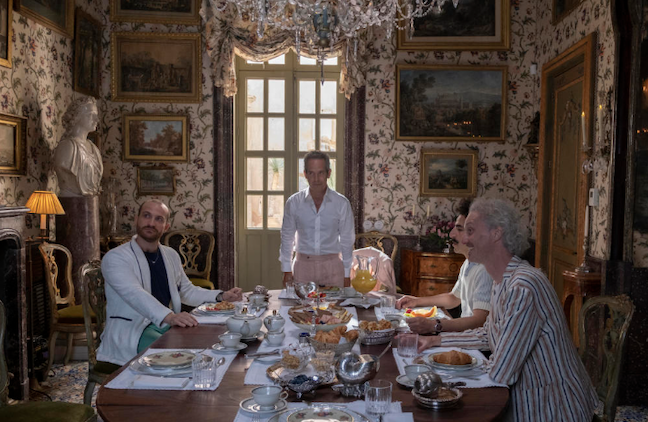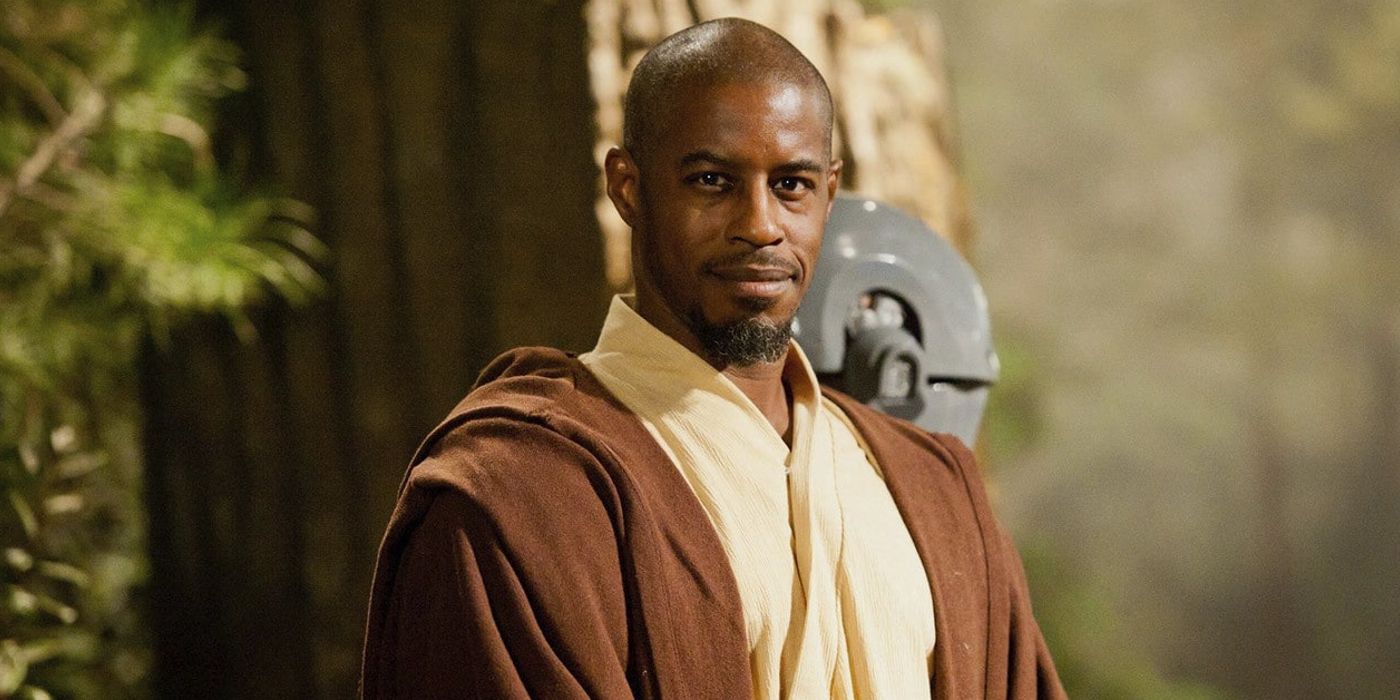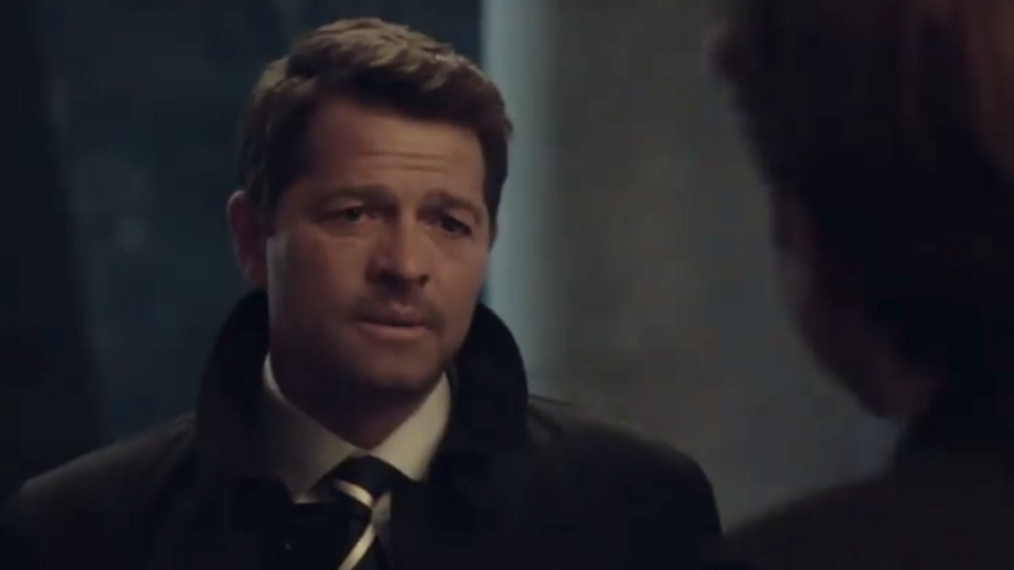Whether or not you’ve watched season 2 of The White Lotus, Mike White’s anthology series, you’ve witnessed Jennifer Coolidge’s frenzied intonations onboard a yacht: “These gays, they’re trying to murder me!”
Coolidge plays Tanya, a wealthy woman who finds herself at the center of a conspiracy to murder her for her money. The executors of this plot are a group of profligate European gay men, who she’s deduced plan to off her before they reach shore. She pleads with the captain, who speaks little-to-no English:
“Do you know these gays? … these gays, they take me off to Palermo, and then they set me up with this guy who’s in the mafia, and he’s coming here, I, I think to try to throw me off the boat. They’re going to do Greg’s dirty work for him because he’s gonna pay them with my money so they can decorate their houses or some shit.”
The captain only understands the word “gay”. He smiles, and replies “tutti gay!” They’re all gay. Crestfallen, Tanya turns away and mutters “oh my god” with absolute resignation. She knows she’s about to be sacrificed at the altar of luxury decor. The gays, who drew Tanya into their circle with warmth and flattery, now embody a smiling, unsparing menace.
The evil gays of The White Lotus are fictitious and cartoonishly sinister, but they also evoke queer villains of the past. In the 2022 popular history book Bad Gays: A Homosexual History, Huw Lemmey and Ben Miller probe the lives of notorious queers to establish a counter-narrative of gay history. Rather than an unflaggingly virtuous and eventually victorious struggle for “rights,” Miller and Lemmey argue that queer history is tainted by the classist, racist, and colonialist ideals of the larger societies that birthed contemporary conceptions of queer identity.
Miller and Lemmey subscribe to the idea, influenced by Michel Foucault and numerous queer theorists and historians, that sexuality is shaped by the time and place someone lives in, rather than being an innate, unchangeable identity. They identify the birthplace of the tie between sexuality and identity as Europe in the mid-to-late 19th century. Industrialization was well underway, which led to cities populated by throngs of wage laborers who were newly able to pursue their sexual interests. Simultaneously, colonial powers propagated the idea that colonized subjects were “backwards” for reasons including sodomy, which helped form the idea that homosexuality was an immoral characteristic rather than simply a behavior, and ultimately led to increased criminalization.
As these two opposing social and political forces intertwined to create a burgeoning awareness of same-sex sexuality, many tried to definitively classify same-sex attraction and behavior, including doctors and sociologists working at a clinical remove and queer people who sought to understand themselves better. The theory of homosexuality as a fixed trait gained traction, and thus homosexuality was “medicalized”: rather than an aberrant behavior, homosexuality was innate and unchangeable, and should be understood as a mental condition.
Miller and Lemmey argue against the medicalization of homosexuality: The idea that gay people are burdened with a condition that can’t be helped ignores that many gay people have chosen to live sexually and socially fulfilling lives. Yet the theory has stuck over time, and Lemmey and Miller argue that it led to the valorizing of gay historical heroes, a strategy that gained traction in the gay rights movement: By classifying people as diverse as Alexander the Great, Sappho, Alan Turing, and Langston Hughes as gay, activists could stake a claim on the eternal existence of queer identity, and argue that queer people have enriched human history.
Not every historical figure we can call ‘gay’ left a positive legacy behind.
This point of view smooths over the wrinkles in gay history: sexuality has not been understood as a stable identity category, and not every historical figure we can call “gay” left a positive legacy behind. Miller and Lemmey argue that examining the “bad gays” of history is just as important to understanding queer history, not to mention contemporary queer life and queer futures, as is uplifting the “good gays” that came before us.
A person who’s paid attention to recent representations of queer life in art and entertainment may have noticed an uptick in morally complex or ill-intentioned queer characters. Two key examples are The White Lotus and Terence Davies’s historical drama Benediction, both 2022 releases which feature groups of self-absorbed gay men who would be apt subjects of Bad Gays. The gay men seen in these narratives are exorbitantly privileged, socially exclusionary, inwardly miserable, and outwardly malicious; they live parasitic lives, extracting value from their hosts before moving onto new victims.
Benediction is a biopic of British poet Siegfried Sassoon, who chronicled the brutality of World War I. Rather than simply telling the story of Sassoon’s life, Davies (who also wrote the film) uses Sassoon as a vessel through which to explore the accumulated injuries that can macerate a man’s soul. Throughout his life, memories of the war linger heavily over Sassoon’s mind (played as a young man by Jack Lowden, and as an old man by Peter Capaldi), but he’s also damaged by a circle of gay men he falls in with. All are based on actual people: the most prominent characters are star of stage and screen Ivor Novello (Jeremy Irvine), socialite Stephan Tennant (Calam Lynch), and theatre actor-director Glen Byam Shaw (Tom Blyth).
This was also a circle that likely would have known several of Bad Gays’ subjects.
For instance, Lord Alfred “Bosie” Douglas was Tennant’s uncle, and Siegfried and Ivor discuss him familiarly—”Bosie was always vindictive,” notes Ivor. Vindictive he was. Bosie engaged in an increasingly reckless love affair with Oscar Wilde that led to Bosie’s father accusing Wilde of sodomy. Egged on by Bosie, who wanted to hurt his father, Wilde sued. He lost the suit, and was subsequently tried for, and convicted of, gross indecency, with a sentence of hard labor that decimated his mental and physical health. Wilde died three years after his imprisonment, and Bosie—who, though typically attributed to Wilde, coined the phrase “the love that dare not speak its name”—went on to publish a virulently anti-Semitic magazine and serve time in jail for libeling Winston Churchill.
The secretive sexual and romantic bonds these men share, in Benediction, create the conditions for bitterness and betrayal.
Lemmey and Miller use the torrid affair and divergent paths of Wilde and Douglas as their opening anecdote: both because they serve as ideal “good gay”/”bad gay” archetypes, and because Wilde’s trial was perhaps the key event that solidified homosexual identity as a concept in the public imagination. That Bosie was a casually familiar figure to the characters in Benediction speaks to how crucial their milieu is to gay history: These men grew up in the shadows of the first steps toward codifying gayness as an identity, and Davies shows this era stage of gay life as turbulent and suffocating. The secretive sexual and romantic bonds these men share, in Benediction, create the conditions for bitterness and betrayal. The four central characters pair off and separate frequently and acrimoniously, and their lives are never fully transparent to one another. Ivor Novello is the most callow and manipulative of all, ditching Glen for Siegfried on first sight, and only revealing to Siegfried that he has a secret “life partner” after a drawn-out, hostile affair. Throughout Benediction, Davies subverts the commonly held idea that honestly expressing one’s queer desires is inherently liberatory: Art and moments of emotional intimacy occasionally allow Siegfried to transcend the traumas of his life, but the time he spends among other gay men depletes him nearly as much as trench warfare.
Season 2 of The White Lotus is set 100 years later and has a much looser relationship with reality, but many of its gay characters are cut from the same cloth. The gays that frequent the White Lotus luxury hotel—in Taormina, where Oscar Wilde lived after his imprisonment and a former gay tourist destination—are a cosmopolitan, indulgent bunch commanded by posh Quentin (Tom Hollander). Writer-director Mike White initially frames them as benevolent: they offer warm compliments and camaraderie toward attention-starved guest Tanya, who’s been left bereft after her husband leaves their vacation early. Because we see them through Tanya’s eyes, we’re led to share her opinion of them: “if you’re looking for a friend, gay guys are really the best.”
Maybe not.
Quentin invites Tanya to his extravagant villa, and it becomes apparent during her stay that his intentions may not be friendly. Only when Tanya’s stuck on a yacht with Quentin and crew does she put the pieces together: her husband Greg has enlisted Quentin to kill her. The terms of their prenup mean that Greg will inherit all of Tanya’s money; he’ll split it with Quentin, who needs it to maintain possession of the villa without opening it to the public.
Quentin’s backstory is mysterious, but key hints are revealed in a late-night conversation he has with Tanya, where he tells the story of his first and only love. As a Kerouac-pilled young man, he followed a “cowboy” to Wyoming for love and to spite his father (shades of Bosie). The cowboy was straight, which only nurtured Quentin’s obsession, and Quentin would still “do anything for” him after 30 years. (The cowboy, of course, is Greg.) The point of the story is for Quentin to opine that he wouldn’t die for love, but that he would die for beauty—which he pointedly asks Tanya if she would do, in effect sizing up her subconscious willingness to die for Quentin’s villa.
Buried in his story is a past filled with shame and isolation because of his sexuality; his father didn’t approve, and he concentrated all of his desire on an unavailable man. Quentin, then, is a suppressed character, and this suppression is sublimated by his devotion to aesthetics. In an earlier episode, he commented that his life has been “one long distraction,” and the implication is that the excesses and luxuries of his life distract him from his lack of emotional fulfillment. White takes this psychological makeup to its logical extension: Quentin shows himself to be completely willing to exploit and sacrifice human life for private property.
Quentin is an outgrowth of unsatisfied homosexuality, shallow devotion to beauty, and capitalistic greed—all working in concert. This is a character profile that fits many a Bad Gay profiled by Lemmey and Miller like a glove, but the one that may be the closest analogue is Philip Johnson, the celebrity architect. Johnson, who grew up in a wealthy family, began his architectural career in earnest when he curated a popular exhibition on modernist architecture for the Museum of Modern Art. As curator, he prioritized aesthetics and de-emphasized the prominent role of social housing in this architectural movement. His career became one of prestige and extravagance, working for clients as rich and odious as Donald Trump and perpetually enacting the most significant philosophies of his life: class superiority and fascism (Johnson was an avowed Nazi sympathizer from the 1930s until the early 1940s, and never fully disentangled himself from his fascist beliefs). By enacting an entirely aesthetic relationship to his profession, Johnson helped lurch architecture to the right through an abdication of social responsibility and the prioritization of wealth.
In the midst of his architectural career, Johnson was also enmeshed in an upper-crust gay social scene. In his home—the Glass House, his most famous building—Johnson regularly hosted the gay cultural elite of the era, including Andy Warhol, Merce Cunningham, Robert Rauschenberg, and his own partner David Whitney. Miller and Lemmey describe the wealthy gay social lives of these men as being both restricted and uninhibited, bound by their sexuality but liberated by their money and cultural cachet. They “lived in closets of power in which their homosexuality could be an open secret, trapped in their privilege like bugs in amber.”
Miller and Lemmey describe the wealthy gay social lives of these men as being both restricted and uninhibited.
Quentin, who is cash-poor but lives a life with an exclusive in-group characterized by excess and outward signifiers of wealth, is portrayed as holding values similar to Johnson. When he notes that he’s “willing to die for beauty,” he means a specific sort of beauty: gilded, rarefied, and European. His full-throttle devotion to aesthetics and his hedonistic social life create a fetish for ownership: the villa must be in his sole possession, anyone who visits must be invited, and the masses should not be granted access. While White does not imbue Quentin with a particular political identity, his embrace of merciless exploitation to serve his luxury lifestyle can be read as a microcosm of the exploitative capitalism that Lemmey and Miller see in Johnson.
What the self-involved and malicious gays of The White Lotus and Benediction point to is a key part of Lemmey and Miller’s argument: that gay activism throughout history has often prioritized the most privileged of queers. What Lemmey and Miller view as an insufficient and exclusionary conception of queerness has primarily stemmed from cisgender, white, middle class-to-wealthy gay men in affluent societies who danced on the knife edge of social and cultural acceptance. While queer sexuality imperiled many—particularly those who lived under criminalization, which disproportionately affected working-class people and colonized subjects—many also developed the ability to keep their stigmatized sexualities in a delicate balance with the otherwise-privileged lives they could lead. The politics that developed from this relationship with homosexuality have historically leaned toward exclusionary assimilation, and lives of gay men ensconced in privilege—such as are depicted in Benediction and The White Lotus—ultimately come at the expense of collective liberation. The cruelty, competitiveness, and exploitation evinced by the characters in each results from the narrowness of their positions: even 100 years apart, assimilation requires rigid self-interest to overtake care for others.
The counter-narrative presented in Bad Gays is as vital to understanding queer history as is elevating queer heroism. Nuanced analysis of how bad actors and exclusionary politics shaped modern concepts of gay identity helps us understand historical and contemporary queerness from all angles. Narrative art like Benediction and The White Lotus does the same, presenting thoughtful depictions of villainous or cruel gay people that can complicate a viewer’s understanding, creating more complete and complex portraits of gay life over the course of history.



























































